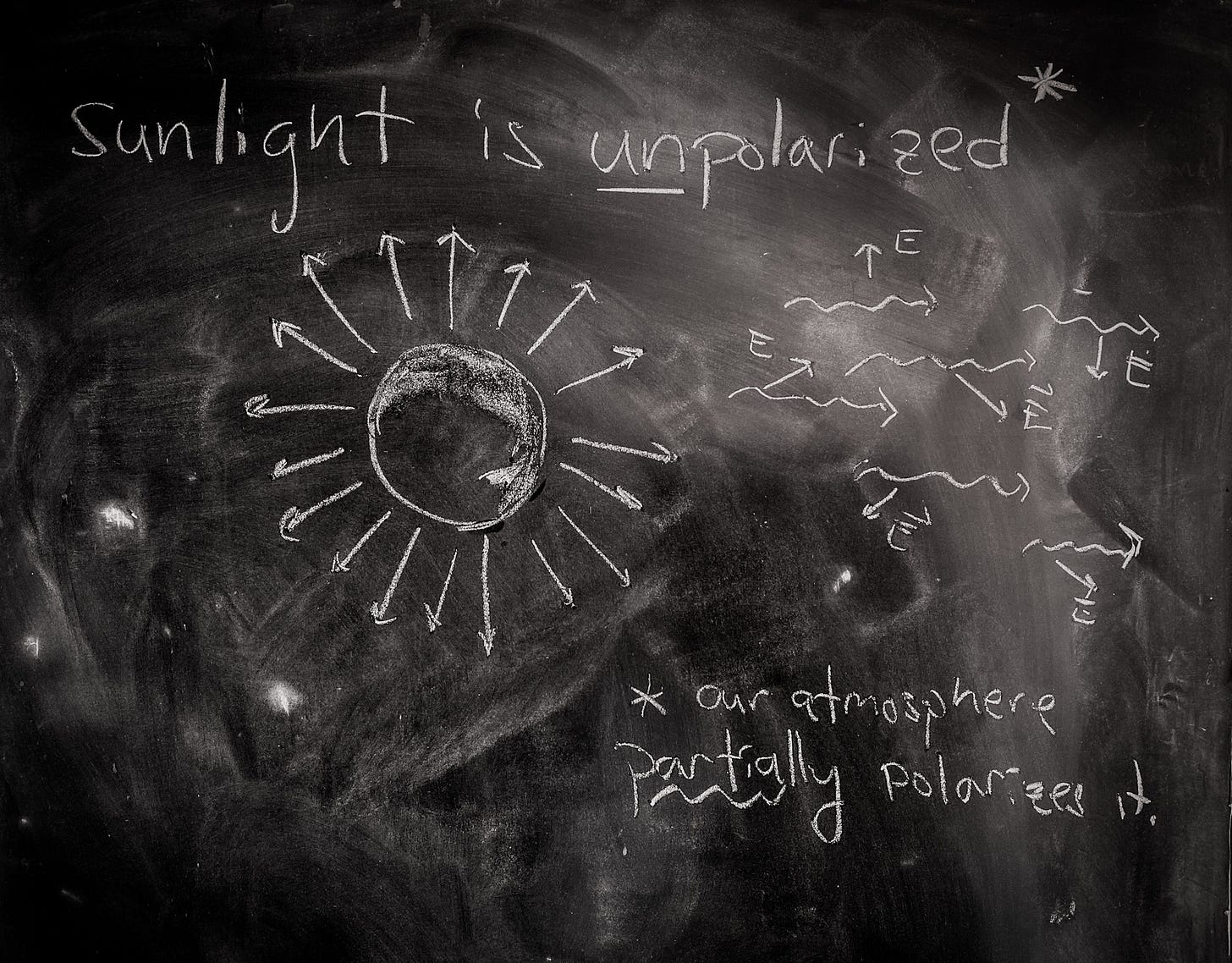Photons and the Polarization of Light
Another interlude before we return to the Stern-Gerlach Experiment
Have you ever tried out a pair polarized sunglasses?
The idea behind a polarization filter is that it reduces the amount of light coming through, typically by half.
Light - you know, electromagnetic waves - can have two polarization modes, both of which are orthogonal to its direction of motion. One way to think about it is asking: which direction does the electric field point?

Now there are all kinds of fun tricks and techniques for polarizing light in different ways. You can have it polarized linearly. You can have it polarized dynamically so that the electric field and magnetic field directions contorts around the beam as it moves. You can pass it through materials like calcite that enhance or enable these effects. But the point is, there are two options.
Polarization Filters in Practice
Unlike the light from your screens, light from the sun1 or your streetlights probably comes at you in all kinds of directions. We say that light’s unpolarized. To to get light polarized with the electric field pointing upwards, we need to pass it through a filter. Something you can put on your sunglasses or camera lens.
Suppose we do.
Now let’s say I pass some light polarized so that the elctric field points up through another filter that also points up. What happens? 100% of the light goes through.

But what happens if I rotate that second polarization filter by 90 degrees? The electric field points up, but the filter points sideways. 0% of the light gets through.

Pretty straightforward right. So what happens when I turn that filter by 45 degrees instead? Fans of classical optics know the answer: 50% of the light gets through2.

Generically, we take the inner product of the two polarization vectors, and get a result that the amount of light coming through depends on the cosine of the angle between them.

Polarization is a Quantum Phenomena
So far so good, right? So far it’s all been pretty much classical, right? Well here’s a question for you:
We learned that lightwaves are quantized by the constant h. Which is fine. Great, even! Individual photons can be polarized. And they all are if the whole light beam is. But what does it mean to say that 50% of the photons move through the polarization filter?
Naïvely you might think:
“Well then half of them make it through and half of them are deflected, big deal. That’s 50%!”
Well. Wait a minute. What happens when we have an odd number of photons? What exactly happens to that last one?

There are no “half” photons
Perhaps now you see the point of why photons make quantum mechanics so weird. You can’t cut that photon in half. Half of that photon doesn’t make it through the filter. Does it?
We certainly do not measure half photons. That’s the whole point of quantum mechanics. So individual photons have a 50/50-chance of making it through that polarization filter.
Now we understand where that rule that 50% of the light comes through when the angle of the second Polaroid filter is 45 degrees. It’s not that it’s cutting the electric field in half. Each photon has a probability of getting through that’s like 50%.
More or Less than Half
It’s not like exactly half the photons make it through, right? Flip a million coins, you’ll get heads close to half a million times, but precisely a million times? That’s nowhere near as common. The variance of that probability distribution scales with the number of flips.

Do you know what else has two polarization states? Silver atoms. They have to spin polarization states. Next time we’ll see how the stern gerlach experiment mimics the idea of a polarization filter.
While the light is polarized before it strikes the atmosphere. Once it strikes the molecules in our atmosphere, it reflects back two two distinct features. First, it’s blue because shorter wavelength light scatters better back down at us. Second, it’s slightly polarized. Not completely, but enough to notice if you wear polarized sunglasses rotate your head around the afternoon sky.
More precisely, half of the intensity of the light passes through. This is Malus’ Law. Classically for light beams, intensity and energy are directly proportional. Intensity is proportional to the square of the magnitude of the electromagnetic field.




